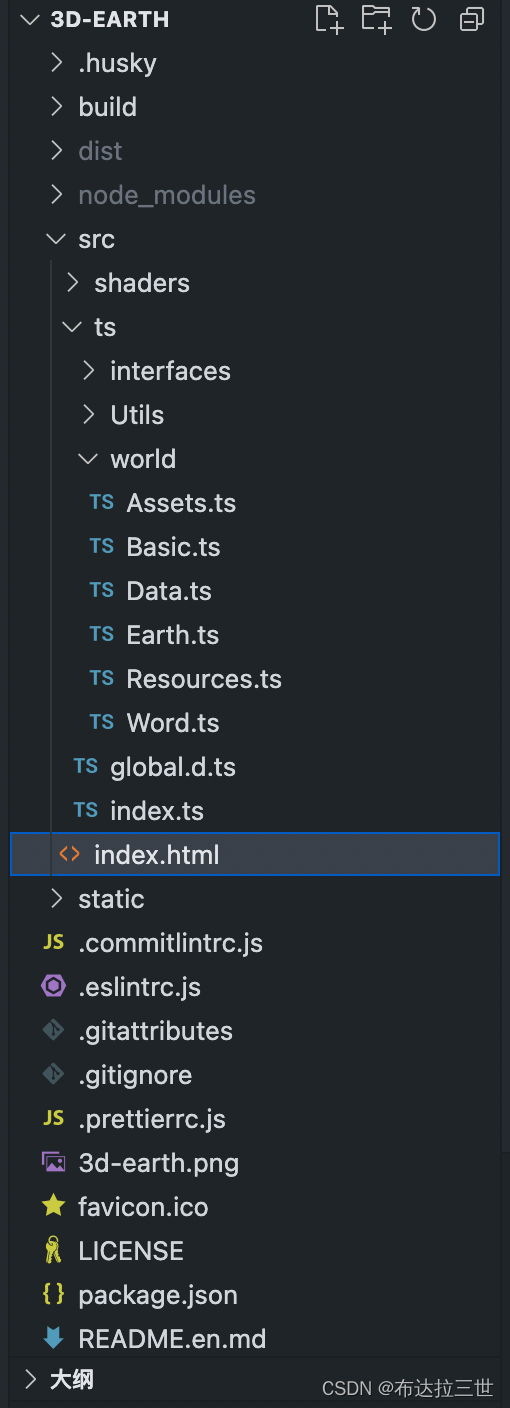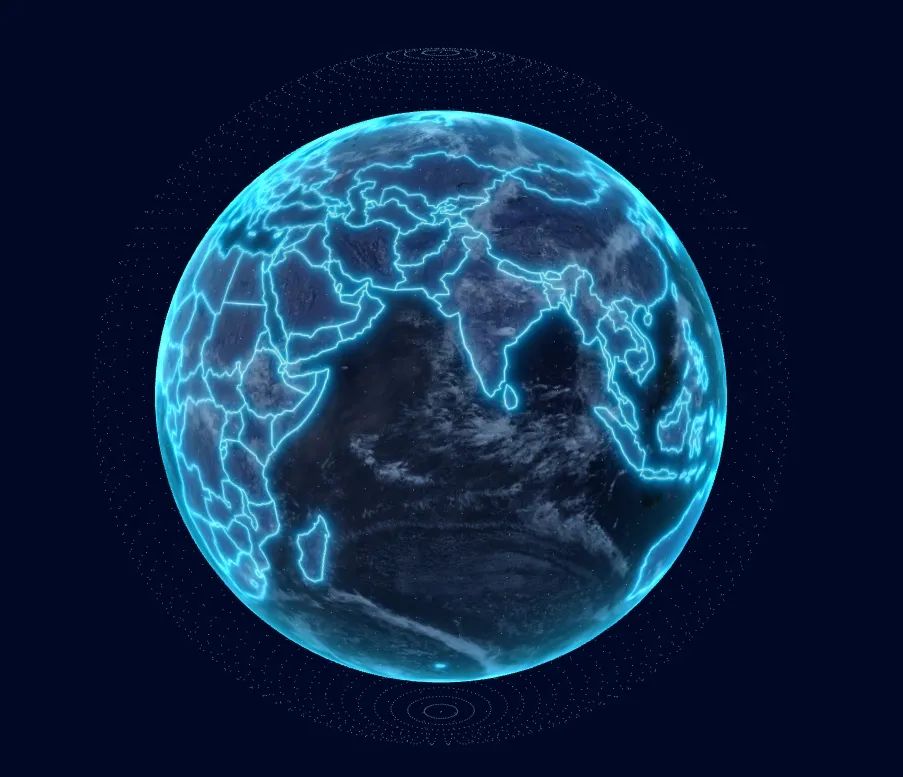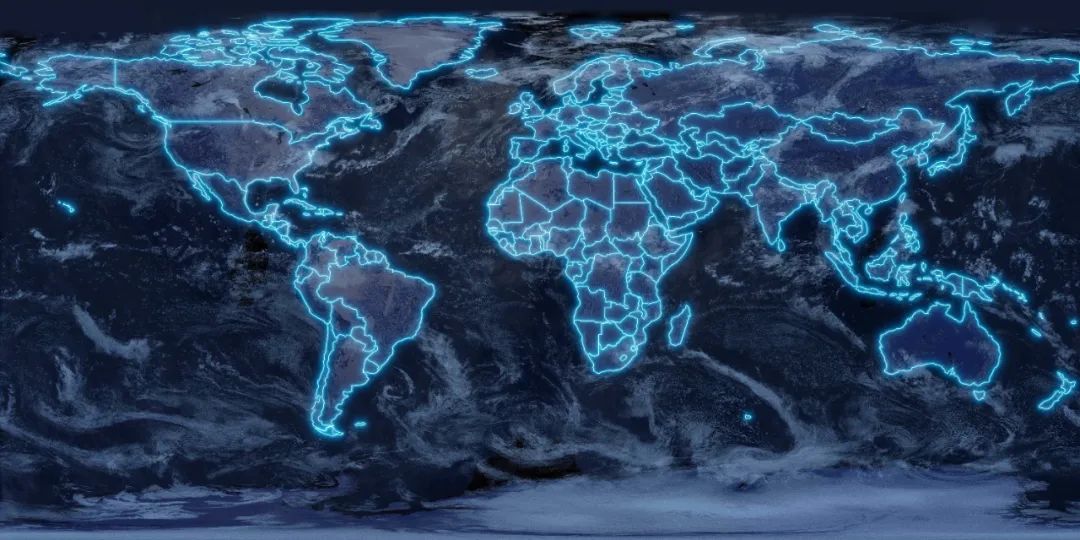# 实现效果

# threejs 基础概念简单介绍
threejs和webgl的关系
three.js经常会和webgl混淆, 但也并不总是,three.js其实是使用webgl来绘制三维效果的。webgl是一个只能画点、线和三角形的非常底层的系统。想要用webgl来做一些实用的东西通常需要大量的代码, 这就是three.js的用武之地。它封装了诸如场景、灯光、阴影、材质、贴图、空间运算等一系列功能,让你不必要再从底层webgl开始写起。
基础threejs场景
一个最基础的three.js程序包括渲染器(renderer)、场景(scene)、相机(camera)、灯光(灯光),以及我们在场景中创建的物体(earth)。
#入口文件
使用webpack打包,src/index.html是入口文件
文件列表

index.html
<div id="loading">
<div class="sk-chase">
<div class="sk-chase-dot"></div>
<div class="sk-chase-dot"></div>
<div class="sk-chase-dot"></div>
<div class="sk-chase-dot"></div>
<div class="sk-chase-dot"></div>
<div class="sk-chase-dot"></div>
</div>
<div>加载资源中...</div>
</div>
<div id="html2canvas" class="css3d-wapper">
<div class="fire-div"></div>
</div>
<div id="earth-canvas"></div>-
#loading: 加载中的loading效果
-
#earth-canvas:将canvas绘制到此dom下面
-
#html2canvas:将html转换成图片,显示地球标点
index.ts
webpack 会将此文件打包成js,放进 index.html 中
import world from './world/word'
// earth-canvas
const dom: htmlelement = document.queryselector('#earth-canvas')
// 将dom传进去
new world({ dom, })world.ts 创建3d世界
// 传入dom,创建出threejs场景、渲染器、相机和控制器。
this.basic = new basic(option.dom)
this.scene = this.basic.scene
this.renderer = this.basic.renderer
this.controls = this.basic.controls
this.camera = this.basic.camera
// 传入dom,主要进行dom尺寸计算和管理resize事件。
this.sizes = new sizes({ dom: option.dom })
this.sizes.$on('resize', () => {
this.renderer.setsize(number(this.sizes.viewport.width), number(this.sizes.viewport.height))
this.camera.aspect = number(this.sizes.viewport.width) / number(this.sizes.viewport.height)
this.camera.updateprojectionmatrix()
})
// 传一个function,资源加载完成后会执行此function。
this.resources = new resources(async () => {
await this.createearth()
// 开始渲染
this.render()
})// 地球相关配置
type options = {
data: {
startarray: {
name: string,
e: number, // 经度
n: number, // 维度
},
endarray: {
name: string,
e: number, // 经度
n: number, // 维度
}[]
}[]
dom: htmlelement,
textures: record<string, texture>, // 贴图
earth: {
radius: number, // 地球半径
rotatespeed: number, // 地球旋转速度
isrotation: boolean // 地球组是否自转
}
satellite: {
show: boolean, // 是否显示卫星
rotatespeed: number, // 旋转速度
size: number, // 卫星大小
number: number, // 一个圆环几个球
},
punctuation: punctuation,
flyline: {
color: number, // 飞线的颜色
speed: number, // 飞机拖尾线速度
flylinecolor: number // 飞行线的颜色
},
}
// 1.将earth中的group添加到场景中
this.scene.add(this.earth.group)
// 2.通过await init创建地球及其相关内容,因为创建一些东西需要时间,所以返回一个promise
await this.earth.init()
// 3.地球创建完之后隐藏dom,添加一个事先定义好的类名,使用animation渐渐隐藏掉dom
const loading = document.queryselector('#loading')
loading.classlist.add('out')
// 1.将earth中的group添加到场景中
this.scene.add(this.earth.group)
// 2.通过await init创建地球及其相关内容,因为创建一些东西需要时间,所以返回一个promise
await this.earth.init()
// 3.地球创建完之后隐藏dom,添加一个事先定义好的类名,使用animation渐渐隐藏掉dom
const loading = document.queryselector('#loading')
loading.classlist.add('out')#加载资源
地球中需要若干个贴图,在创建地球前,先把贴图加载进来。
assets.ts 整理资源文件
/**
* 资源文件
* 把模型和图片分开进行加载
*/
interface itextures {
name: string
url: string
}
export interface iresources {
textures?: itextures[],
}
const filepath = './images/earth/'
const filesuffix = [
'gradient',
'redcircle',
"label",
"aperture",
'earth_aperture',
'light_column',
'aircraft'
]
const textures = filesuffix.map(item => {
return {
name: item,
url: filepath + item + '.png'
}
})
textures.push({
name: 'earth',
url: filepath + 'earth.jpg'
})
const resources: iresources = {
textures
}
export {
resources
}
通过使用threejs提供的loadingmanager方法,
管理资源的加载进度,以及保存一个textures对象,
key为name,value为texture对象
#添加地球


-
earth:创建一个地球mesh,
并赋予shadermaterial材质和贴上地球贴图,
之后可以通过着色器动画实现地球扫光效果。
-
points:创建一个由points组成的包围球,
放在外围。
const earth_geometry = new spherebuffergeometry(
this.options.earth.radius,
50,
50
);
const earth_border = new spherebuffergeometry(
this.options.earth.radius + 10,
60,
60
);
const pointmaterial = new pointsmaterial({
color: 0x81ffff, //设置颜色,默认 0xffffff
transparent: true,
sizeattenuation: true,
opacity: 0.1,
vertexcolors: false, //定义材料是否使用顶点颜色,默认false ---如果该选项设置为true,则color属性失效
size: 0.01, //定义粒子的大小。默认为1.0
})
const points = new points(earth_border, pointmaterial); //将模型添加到场景
this.earthgroup.add(points);
this.options.textures.earth.wraps = this.options.textures.earth.wrapt =
repeatwrapping;
this.uniforms.map.value = this.options.textures.earth;
const earth_material = new shadermaterial({
// wireframe:true, // 显示模型线条
uniforms: this.uniforms,
vertexshader: earthvertex,
fragmentshader: earthfragment,
});
earth_material.needsupdate = true;
this.earth = new mesh(earth_geometry, earth_material);
this.earth.name = "earth";
this.earthgroup.add(this.earth);




发表评论